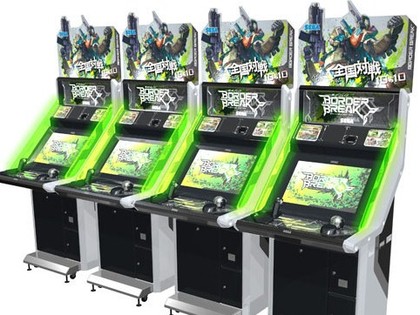The best and the weirdest new games in Japanese arcades
When the going gets weird, the weird head to Akihabara
"The arcade industry in Japan is currently in the process of retooling," says Brian Ashcraft. "There are inventive and imaginative business models in place - such as the example being set by what shoot 'em up developer Cave is doing with its games and arcades."
Cave, for the uninitiated, is the Japanese developer behind shmup classics as Mushihime-sama Futari, and the leading developer is now releasing its arcade games to Japanese arcade owners for free, taking a percentage of the profits from each machine. Which, as Ashcraft notes, "means arcades have much lower risk than with traditional arcade games."
Like most attendees at this year's AOU, Ashcraft was quite taken with Konami's ability to "continue to produce beautiful and impressive arcade cabinets, while testing out things like 3D goggles with the upcoming Metal Gear Arcade," while also name-checking companies like Taito for "rebooting arcade franchises like Elevator Action in new ways."
Also, he reminds us that many popular hardcore titles on console still follow the arcade's lead in Japan: "Lest we not forget, some of the most impressive recent fighting games, like BlazBlue, debuted in arcades."

BORDER BREAK: Sega released a new update to its popular arcade game at AOU 2010
However, all is not peachy-creamy in the land of the Japanese gaming parlour, with the recent tough times in the world economy taking their toll.
"The economy in Japan has been tough," says Ashcraft, "not just for arcade games, but for video games as well as manga publishers. Disposable income is lower now than in years past and everyone is feeling the pinch."
Get daily insight, inspiration and deals in your inbox
Sign up for breaking news, reviews, opinion, top tech deals, and more.
Despite the infernal credit crunch effect, there are still a number of innovations in Japanese arcade gaming that haven't (yet) made it to the west, with Ashcraft citing the card game craze in particular. "Something that has brought Square Enix, primarily a console game maker, into the arcade scene. Of course, Square Enix owns Taito, so there is a strong arcade connection for the company."
In addition to the Metal Gear Arcade and the video announcement of Virtua Fighter 5: Final Showdown, Ashcraft's top tips from AOU 2010 include Melty Blood Actress Again Current Code,
Project DIVA Arcade and "the world's first two-legged robot amusement machine" Robo Catcher (which you can see a video demo of right here).
Sega sees money in medals
Sega Corporation's Takuya Kishimoto, is the man responsible for overseas arcade sales. He is tasked with accurately predicting which of Sega's arcade machines will work in western arcades.
Kishimoto is the first to admit that the Japanese arcade industry is facing tough times, noting that the industry's "population itself may be bit steady or bit decreasing" and that "visitors to AOU has decreased to 85% compared to last year, on both Business Day and Public Day."
The Sega rep informs us that Japanese arcade operators are currently earning money in "Medal Games" where people buy tokens (or medals) that can't be changed back to money, "and many casual players and core medal game fans play certain games to enjoy trying to get more tokens just for fun."
'Entertainment Photo Machines' are also proving very popular with the young ladies of Tokyo, according to Kishimoto, where high resolution pictures are printed on to stickers and players can "fabricate pictures taken to make yourself more cute." But it's difficult to see how those kinds of machines would make Sega any money outside of its homeland. So what about the videogames?
"Games are now very steady on population, but have changed their trend to on-line games," says Kishimoto, adding, "recent features for these are 'compliant to mobile phones/internet', 'frequent update on software' and 'online player vs player'."
Sega Amusements was showing off some cracking new games at this year's AOU including Sengoku Taisen (a popular new card game based around Japanese History), Border Break Ver1.5 (an update for the one of the top three earning games in Japan right now) and music game Project DIVA ("using a popular character to internet geeks called Hatsune Miku," says the Sega rep!).
Our favourite weird Japanese arcade games
If that last title doesn't sound strange and geeky enough for the non-Otaku amongst us, there are always guaranteed to be some barking mad new arcade games that arrive each year that cause no end of amusement to western tourists wandering around Akihabara's gaming and pachinko parlours.
Brian Ashcraft's love of Robo Catcher – a game in which you move a real-life robot with a joystick and buttons to get a prize - indicates one new trend in Japan's arcade scene, but there are a few others to watch out for the next time you are lucky enough to be in Tokyo with some free time to kill, including, in no particular order:
Chabudai Gaeshi ('Pull over the table' – in which you flip a table and are scored by how many things you break on the table and in the room).
Omatsuriya-san Takoyaki (A game where you can imitate making a traditional food in Japan called Takoyaki which features a "smell unit" attached which realistically reproduces the smell of the food).
Gundam Senjyou no Kizuna (Using the famous animation "Gundam", a robot action game where player gets inside a pod to move the robot, where online players can fight against other players in a different location).
Grand Cross (A huge medal game where 32 players can play at once. The machine is almost as big as a Luton Van).
Taito's pogo stick inspired game Hopping Road – where players control cartoon characters bouncing round the race course.
Canadian developer TrioTech Amusement's STOMPER DLX – which uses a special floor projector system that allows the players movements to interact with various game scenarios.
Sega's Heat Up Hockey: IMAGE – a projected playing field overlaying a conventional air-hockey table.
Tetris Giant – the puzzle game played with giant vibrating joysticks and projected onto a big screen.
-------------------------------------------------------------------------------------------------------
Liked this? Then check out 14 arcade machines that led to a misspent youth
Sign up for TechRadar's free Weird Week in Tech newsletter
Get the oddest tech stories of the week, plus the most popular news and reviews delivered straight to your inbox. Sign up at http://www.techradar.com/register
